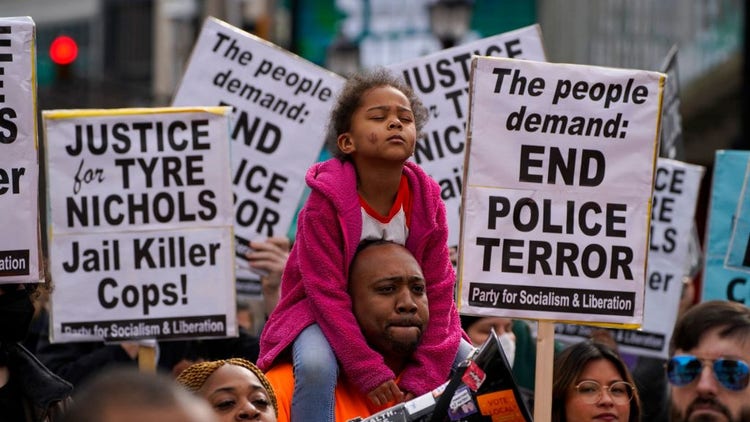
The views expressed in this article are those of the author and do not necessarily reflect the official policy or position of any other agency, organization, employer or company.
Lightning didn’t flash. Thunder didn’t roll. No breakers dashed nor fierce wind unfold the night Memphis Police Department released the video footage of more than five police officers beating Tyre Nichols to death at what should have been an uneventful traffic stop in Memphis.
“I’m supposed to drive down today, but I won’t if it’s looking like Watts Riots,” said my sorority sister who is now an attorney living in Gulfport, Mississippi. She’s from Memphis — graduated high school and college here. She’s adamant that she won’t ever move back home. She’s experienced enough trauma. It’s not home for her anymore for several reasons that are not my story to tell.
“Daycare is closing early,” responded another friend in our group chat. She’s pregnant with her second child, living in the city’s Binghampton community with her husband and daughter. The daycare closed early due to the expectation of protests and violence after the release of the video. Days leading up to the moment of truth, public officials testified that it was horrific. Memphis Police Chief CJ Davis called it worse than Rodney King. My pregnant friend chose not to watch the video for her mental health after wrestling with the decision for the week.
“Do y’all think it’s really going to get bad?” interjected another friend. She lives in Whitehaven, blocks away from where police captured 19-year-old Ezekial Kelly after a day the city was locked down as he went around and killed seven people. She is a natural worrier — concerned about social and cultural issues, and their impact on our lives as she starts each day with the morning news and invites us to discuss before we all start our work day in earnest.
This led to several responses on social media from onlookers commending Memphis for “showing the world what peaceful protest looks like.”
Rightfully so.
Black people are exhausted, across the nation, with the news and social media reels of Black death and violence. Whether in the hands of police or a fellow community member, the rise in disinterest in engaging with painful, traumatic media that show the violent oppression of Black folks seems to spread across generational lines.
Thus, when the video released at 6 p.m. on Friday, Jan. 27, the usual group of activists gathered on the Memphis-Hernando Bridge, a quarter of the size of the protest on July 10, 2016. As predicted by myself and many folks who breathe this Memphis air everyday, nothing much happened.
Memphis was praised for the peaceful protests that occurred throughout the weekend. Some said it’s the way protesting should be, echoing the desires from Nichols’ family.
For a week leading up to the release, media and public officials warned of violent responses. Using language to describe the video as “egregious” and media using phrasing like “brace ourselves” sent a message to the public that the response to the footage would be that of violence and chaos.
National and local media overstated that the Nichols family called for peaceful protests while stationing their cameras in front of 201 Poplar in Downtown Memphis and along the I-55 Bridge in preparation to capture the grave reaction. It was clear that everyone was expecting riots, looting and carnage.
And that didn’t happen. None of that happened.
This led to a number of responses on social media from onlookers commending Memphis for “showing the world what peaceful protest looks like.” But Memphis was everything but peaceful the night and weekend of the video release. Just because people weren’t looting, rioting, or in stand-offs with the police is no indication that peace lives in Memphis.
Many older Memphians will attest that the killing of Dr. King still hovers over the city like a death sentence.
The city is beautiful. It’s rich in culture, storytelling, and the people who live here dedicate some version of themselves to something bigger than themselves. However, the lack of righteous indignation in the streets as a response to the death of Tyre Nichols is not a sign of a growing disinterest. It’s not a sign that people aren’t aware of the issues here. We may be hyper-aware, in reality. We know the stats, the data, and the previous administrations that caused more disarray than those who fought for true policies that would benefit us all.
We’re exhausted.
From the race riots of 1866 to the looming mayoral race with too many Democratic contenders in the field, the massacre of Black Memphians didn’t just end when someone ran out of billy clubs — but when billy clubs turned into the plunder of public education, the tasers of poverty, and the handcuffs of hopelessness.
What big media should have dug deeper into was not why the city didn’t burn that night of the release, but if the lack of a response was indicative of a city already razed to the ground.
Praising Memphis for peacefulness is pacifying its residents for not responding to their own oppression.
Protesting is the act of disrupting and calling attention to a system or practice that oppresses a demographic of people. During these times, we often see the words of Dr. King circulate on social media, “Riots are the language of the unheard.”
Let me be clear that I am not criticizing Memphis for not rioting nor burning down buildings. However, praising Memphis for peacefulness amid grave oppression from crippling systems from the police to city hall to the education system is worth examining. Peacefulness is not synonymous with apathy and fear.
Fear kept us in our homes. Exhaustion keeps us from moving forward.